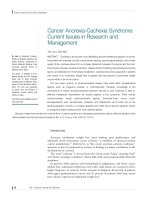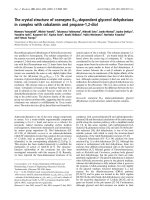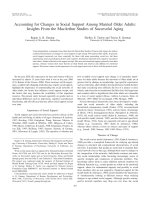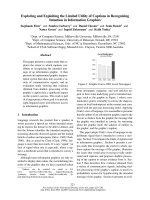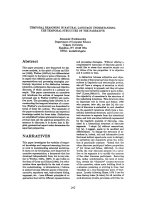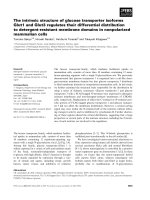Current issues in linguistic theory 71 William ogrady categories and case the sentence structure of korean john benjamins publishing company (1991)
Bạn đang xem bản rút gọn của tài liệu. Xem và tải ngay bản đầy đủ của tài liệu tại đây (20 MB, 303 trang )
CATEGORIES AND CASE
AMSTERDAM STUDIES IN THE THEORY AND
HISTORY OF LINGUISTIC SCIENCE
General Editor
E.F. KONRAD KOERNER
(University of Ottawa)
Series IV - CURRENT ISSUES IN LINGUISTIC THEORY
Advisory Editorial Board
Henning Andersen (Los Angeles); Raimo Anttila (Los Angeles)
Thomas V. Gamkrelidze (Tbilisi); Hans-Heinrich Lieb (Berlin)
J. Peter Maher (Chicago); Ernst Pulgram (Ann Arbor, Mich.)
E. Wyn Roberts (Vancouver, B.C.); Danny Steinberg (Tokyo)
Volume 71
William O'Grady
Categories and Case
The Sentence Structure of Korean
CATEGORIES AND CASE
THE SENTENCE STRUCTURE OF KOREAN
WILLIAM O'GRADY
University of Calgary
&
University of Hawaii at Manoa
JOHN BENJAMINS PUBLISHING COMPANY
AMSTERDAM/PHILADELPHIA
1991
Library of Congress Cataloging-in-Publication Data
O'Grady, William D. (William Delaney), 1952Categories and case : the sentence structure of Korean / William O'Grady.
p.
cm. - (Amsterdam studies in the theory and history of linguistic science.
Series IV, Current issues in linguistic theory, ISSN 0304-0763; v. 71)
Includes bibliographical references and index.
1. Korean language ~ Morphology. 2. Korean language ~ Case grammar. 3. Korean
language - Categorical grammar. I. Title. II. Series.
PL919.035
1991
495.7'5--dc20
90-42137
ISBN 90 272 3569 7 (Eur.)/l-55619-127-8 (US)(alk. paper)
CIP
© Copyright 1991 - John Benjamins B.V.
No part of this book may be reproduced in any form, by print, photoprint, microfilm, or
any other means, without written permission from the publisher.
Contents
1.
2.
3.
4.
5.
6.
7.
8.
9.
10.
11.
12.
13.
14.
15.
16.
Acknowledgements
List of Abbreviations
The Yale System of Romanization
vi
vii
viii
The Problem
The Grammar
Grammatical Relations and Thematic Roles
The Case System
Passivization and Dative Advancement
Possessor Ascension
Inversion Constructions
Focus Constructions
Subject-to-Object Raising
Lexical Causatives
Syntactic Causatives
Case and Word Order
Floated Quantifiers
Some Special Challenges
The Acquisition Problem
Concluding Remarks
1
13
25
33
47
67
97
117
139
153
171
197
211
225
249
269
Notes
References
Index
275
283
293
Acknowledgements
While working on this project I benefitted from the assistance of a number of
people. First of all, I would like to express my deep gratitude to Sook Whan Cho,
whose work on the acquisition of Korean first got me interested in that language and
who subsequently encouraged me to work on the problem of case marking.
Special thanks are also due to Young-Seok Choi and Sung-Ock Shin, who
served as my principal informants and who provided invaluable comments on an
earlier version of this manuscript. I am also very grateful for the help of D.-J. Lee,
my first Korean teacher, who read and commented on different versions of the
manuscript, noting many problems and providing invaluable help with the Korean
data. His assistance and insights helped mefindmy way out of many deadends. Don
Frantz also read the manuscript in its entirety and made many valuable suggestions,
for which I am very grateful. Additional important data and comments were provided
by Younghee Na, Keon-Soo Lee, Yutaka Sato, Kazue Kanno, Gyung-Ran Kim,
Hak-neung Joo, Eung-Do Cook, Joe Ree, Konrad Koerner and two anonymous
referees, to whom I express my thanks. Needless to say, any remaining errors are
my responsibility.
The production of the final version of the manuscript was due in large part to
the efforts of Betty Lewis, Susan Langley and Kazue Kanno. Without their help and
hard work, this project could not have been completed.
List of Abbreviations
Ac
Adv
Caus
Clas
Comp
Dat
Decl
FQ
Gen
Hon
Inf
IV
loc
N
Nmnlzr
NPa
NPc
NPexp
NPl
NPr
NPt
Pass
Pl
Poss
pro
Pst
Q
Rel
Sg
T
TTV
TV
accusative
adverb
causative
classifier
complementizer
dative
declarative
floated quanitifer
genitive
honorific
infinitive
intransitive verb
locative
nominative
nominalizer
actor NP
causer NP
experiencer NP
locative NP
recipient NP
theme NP
passive
plural
possessor
pronoun
past
question particle
relative clause ender
singular
topic
ditransitive verb
transitive verb
The Yale System of Romanization
(' marks a tense consonant)
Hangul Yale Basic Phonemic
Realization
Hangul Yale
-Il
41
/P7
■A
wcy
s
/t/
/th/
/t'/
/s/
way
M
SS
/s7
M
H
H
•Ml
—
u
;*
*
/e/
ch
/Ch/
*
cc
/č'/
-i
/k/
/kh/
/k'/
V-
kh
kk
m
n
0
ng
/m/
/n/
/n/
e
I
l/
•*-
h
i
wi
P
ph
/p/
/ph/
e
PP
t
th
tt
tí
XL
W
=!
TI
1
)
/h/
/i/
/wi/
1
4
-H
h
Y
-4
ey
Basic Phonemic
Realization
/e/
/ye/
/we/
oy
/œ/
ay
/ e / , /æ/
/ y e / , /yæ/
yay
/ w e / , /Wæ/
/w/
e
//
ye
//
we
/We/
a
//
ya
wa
//
/wa/
T
wu
//
TT
yu
/yu/
_1_
0
--
yo
4
uy
//
/yo/
/1/
***1***
The Problem
The study of morphological case constitutes one of the oldest and most
puzzling research problems in the study of language. From the time of Panini in
ancient India and the Stoics in ancient Greece, the role of case affixes in sentence
formation has represented an ongoing challenge for linguistic analysis. If there is one
sentiment shared by all those who have examined this problem, it is that case has a
very fundamental grammatical function, as evidenced by both its ubiquity in human
language and by its association with such basic syntactic notions as subject and direct
object. What still remains to be discovered after several centuries of inquiry is the
precise nature of the information encoded by case categories and the motivation for
this particular use of a grammar's resources. This book seeks to uncover the
principles governing the use of case suffixes in Korean, a language spoken by over
sixty million people on the Korean peninsula as well as in parts of China and the
Soviet Union (not to mention immigrants to the United States and Canada).
To the speaker of English who is exposed to Korean for the first time, at least
two properties of sentence structure come immediately to the fore. First, the Korean
verb is heavily agglutinating, frequently consisting of half a dozen or more
morphemes. For example, the verb form used in a sentence such as 'The deposed
king was caught ' has the structure depicted in (1) (Sohn 1987).
(1)
cap-hi-si-ess-sup-ni-ta
cap =catch; -Ai =passive; -si =subject honorific, -ess =past; -sup =hearer
honorific, -ni =indicative mood and -ta =declarative marker.
Second, although Korean is a strictly 'head-final' language that favors SOV sentence
patterns, the grammar allows relatively free ordering of a verb's arguments and
adverbial modifiers. Hence the following two sentences are both acceptable.
(2) a. Ai-ka pap-ul mek-ess-ta
child-N food-Ac eat-Pst-Decl
'The child ate the food.'
2
CATEGORIES AND CASE
b. Pap-ul ai-ka mek-ess-ta
food-Ac child-N eat-Pst-Decl
'The child ate the food.'
This 'free word order' option is made possible in part by the existence of the case
particles whose precise properties constitute the central concern of this book.
Before proceeding, it is necessary to comment briefly on the presentation of
the example sentences used throughout this book. Following the common practice in
linguistic work on Korean, I use the Yale system of romanization (Martin 1954,
1963), with a few minor modifications.1 Yale romanization establishes a virtual oneto-one correspondance between Roman letters (including some digraphs) and the
symbols of Hangul, the Korean alphabet (see the table at the beginning of this book).
For those unfamiliar with Korean, it is perhaps worth mentioning that because
Hangul is a morphophonemic orthography, neither it nor the Yale system of
romanization provides a straightforward phonetic record of Korean speech.
The Korean verbs used in the vast majority of example sentences in this book
are in the so-called 'plain' form, consisting of a root, a tense marker, (-ass , -ess or
-ss for the past, 0 for the non-past), the 'processive mood' marker -(nu)n (for nonstative verbs in the non-past), and the declarative suffix -m , which can also be used
without tense suffixes to indicate a verb's neutral or 'dictionary' form. Since tense
and mood markers are irrelevant to the issues that concern me here, I will consistently
ignore them in the glosses I give for the Korean examples. In order to further
facilitiate the analysis of example sentences by nonspeakers of Korean, I will use
English proper names as subjects and direct objects where feasible. In this, I follow a
practice common in the literature on Korean.
The Case Suffixes of Korean
In the pages that follow I will be primarily concerned with the function and
distribution of three case particles, the nominative suffix (-ka after stems ending in a
vowel, -i elsewhere), the accusative (-lul after stems ending in a vowel, -ul
elsewhere), and the genitive (-uy ). A fourth particle, the suffix -kkeyse, which
replaces the nominative in certain patterns where the nominal refers to someone of
high social status and which is often considered to be the 'high form' of the
nominative ending, will not be considered here. The following sentences exemplify
the use of Korean case suffixes with NPs bearing a variety of thematic roles.
THE PROBLEM
a. NOMINATIVE SUFIX MARKING AN ACTOR
Kay-ka John-ul mwul-ess-ta
dog-N John-Ac bite
'The dog bit John.'
b. NOMINATIVE SUFFIX MARKING A PATIENT
John-i mwul-li-ess-ta.
John-N bite-Pass
'John was bitten.'
C. NOMINATIVE SUFFIX MARKING A POSSESSOR
John-i son-i aphu-ta.
John-N hand-N hurt
'John's hand hurts.'
a. ACCUSATIVE SUFFIX MARKING A PATIENT
John-i chayk-ul ilk-ess-ta.
John-N book-Ac read
'John read the book.'
b. ACCUSATIVE SUFFIX MARKING A RECIPIENT
Nay-ka John-ul chayk-ul cwu-ess-ta.
I-N John-Ac book-Ac give
'I gave John a book.'
C. ACCUSATIVE SUFFIX MARKING AN ACTOR
John-i Sue-lul hakkyo-ey ka-key hay-ss-ta.
John-N Sue-Ac school-to go-Comp do
'John let/made Sue go to school.'
d. ACCUSATIVE SUFFIX MARKING A POSSESSOR
Kay-ka Mary-lul son-ul mwul-ess-ta.
dog-N Mary-Ac hand-Ac bite
'The dog bit Mary's hand.
a. GENITIVE SUFFIX MARKING A POSSESSOR
John-uy chayk
John-Gen book
'John's book'
4
CATEGORIES AND CASE
b. GENITIVE SUFIX MARKING AN ACTOR AND A PATIENT
John-uy caki-uy piphan
John-Gen self-Gen criticism
'John's criticism of himself
In choosing to focus on these particles, I take the position that they are qualitiatively
different from two other classes of postnominal morphemes in Korean: (a) the class
of 'postpositions' that includes -eyse 'in, at, on', -eyuyhay(se) 'by', -(u)lo 'to, by
means of, -hako 'with', and so on; and (b) the class of 'delimiters' (Yang 1972) that
includes- 'only', -to 'also',-pafc&ey 'nothing but',-Mad 'even', and so on.
It is relatively easy to distinguish between case markers and delimiters since
the latter carry quantificational information and do not make the structural distinctions
typically associated with case. In fact, as the following sentences show, the same
delimiter can appear with either a subject or a direct object (for some general
discussion, see I. Lee 1977).
(4) a. -MAN 'only'USED WITH A SUBJECT
John-man holangi-lul po-ass-ta.
John-only tiger-Ac see
'Only John saw a tiger.'
b. -MAN 'only' USED WITH A DIRECT OBJECT
John-i holangi-man po-ass-ta.
John-N tiger-only
see
'John saw only a tiger.'
(5) a. -TO 'also'USED WITH A SUBJECT
John-to Sue-lul po-ass-ta.
John-too Sue-Ac see
'John too saw Sue.'
b. -TO 'also'USED WITH A DIRECT OBJECT
John-i Sue-to po-ass-ta.
John-N Sue-too see
'John saw Sue too.'
The major difference between case markers and postpositions is categorial:
whereas the former elements mark NPs, the latter head PPs. A simple distributional
test distinguishes case markers from postpositions in Korean. As the following
THE PROBLEM
5
sentences show, case suffixes differ from postpositions in not being able to precede
other postnominal particles.2
(6) CASE MARKERS PRECEDING OTHER PARTICLES
a. *-- John-ul mwul-ess-ta.
dog-N-only John-Ac bite
'Only the dog bit John.'
b. *Chayk-ul-un John-i ilk-ess-ta.
book-Ac-T John-N read
'John read the BOOK.'
*John-uy-man cha
John-Gen-only car
'John and only John's car'
(7) POSTPOSITIONS PRECEDING OTHER PARTICLES
a. Hakkyo-eyse-nun John-i kongpwu ha-n-ta.
school -at -T John-N study
do
'John is studying at school.'
b. Cha-lo-man salam-i ka-n-ta.
car-by-only man-N go
'The man travels only by car.'
A second characteristic distinguishing case suffixes from postpositions is their
optionality in at least certain patterns in the spoken language, given the approporiate
discourse conditions and shared background knowledge (see, for example, Lee and
Thompson 1987).
(8) a. OPTIONAL NOMINATIVE SUFFIX
Mas(-i) iss-ta.
taste(-N) exist
'(It) is tasty.'
b. OPTIONAL ACCUSATIVE SUFFIX
Haksayng-i chayk(-ul) ilk-ess-ta.
student-N book(-Ac) read
'The student read a book.'
6
CATEGORIES AND CASE
. OPTIONAL GENITIVE SUFFIX
John(-uy) chayk
John(-Gen) book
'John's book'
In contrast, deletion of postpositions is generally not permitted (for some discussion,
see Na 1986:119ff).
(9)
John-i hakkyo-*(eyse) kongpwu ha-n-ta.
John-N school (at)
study
do
'John is studying at school.'
(10)
Chayk-i John-*(eyuyhayse) phal-li-iss-ta.
book-N John (by)
sell-Pass
'The book was sold by John.'
The Status of the Dative Marker
A long-standing problem in Korean grammar has to do with the status of the
so-called 'dative' particle -eykey, which is sometimes classified as a postposition and
sometimes as a case marker (see, for example, Hong 1985). Because the use of
Korean -eykey extends well beyond the expression of goals and recipients, the term
'dative' is technically somewhat inappropriate. Nonetheless, for the sake of
continuity and ease of exposition, I will use this term throughout this book to label
any occurrence of the particle -eykey.
Distributionally, -eykey patterns like a postposition rather than a case marker.
Thus, we find sentences such as those in (1), in which -eykey may co-occur with a
topic marker and a delimiter, respectively.
(1) a.
-EYKEY
WITH A TOPIC MARKER
John-eykey -nun nay-ka chayk-ul cwu-ess-ta.
John -Dat -T I-N book-Ac give
'As for John, I gave a book to (him).'
b.
-EYKEY WITH A DELIMITER
Kay-eykey-man John-i mwul-li-ess-ta.
dog-Dat-only
John-N bite-Pass
'John was bitten by only the dog.'
THE PROBLEM
7
Moreover, as the following sentence shows, -eykey differs from case suffixes and
resembles postpositions in being obligatory.3
(2)
John-i Sue-*(eykey) malhay-ss-ta.
John-N Sue(-Dat)
speak
'John spoke to Sue.'
Another difference between genuine case suffixes and -eykey is noted by
Kuh (1987), who observes that the dative particle differs from the nominative and
accusative markers in being able to occur inside a coordinate structure. In this, it
resembles postpositions.
(3) a. NOMINATIVE SUFFIX APPEARING OUTSIDE COORDINATE STRUCTURE
[Joe-kwaMary]-ka yenay-lul ha-n-ta.
Joe-andMary -N love-Ac do
'Joe and Mary are in love.'
b. NOMINATIVE SUFFIX APPEARING INSIDE COORDINATE STRUCTURE
*[Joe-ka -kwa Mary]-ka yenay-lul ha-n-ta.
Joe-N -and Mary -N love-Ac do
(4) a. ACCUSATIVE SUFFIX APPEARING OUTSIDE COORDINATE STRUCUTRE
Chelswu-ka [emeni-wa apeci]-/w/ mosi-ess-ta.
Chelswu-N mother-and father -Ac support
'Chelswu supported his mother and father.'
b. ACCUSATIVE SUFFIX APPEARING INSIDE COORDINATE STRUCUTRE
*Chelswu-ka [emeni-lul -wa apeci]-lul mosi-ess-ta.
Chelswu-N mother--and father-Ac support
(5) a. GENITIVE SUFFIX APPEARING OUTSIDE COORDINATE STRUCTURE
[John-kwa Mary]-uy chayk
John-and Mary-Gen book
'John and Mary's book'
b. GENITIVE SUFFIX APPEARING INSIDE COORDINATE STRUCTURE
*[John-uy -kwa Mary]-uy chayk
John-Gen-and Mary -Gen book
8
CATEGORIES AND CASE
(6) a. DATIVE PARTICLE APPEARING OUTSIDE COORDINATE STRUCTURE
John-i [Mary-wa Sue]-eykey senmwul-ul cwu-ess-ta.
John-N Mary-and Sue -Dat present-Ac give
'John gave a present to Mary and Sue.'
b. DATIVE PARTICLE APEARING INSIDE COORDINATE STRUCTURE
John-i [Mary-eykey -wa Sue]-eykey senmwul-ul cwu-ess-ta.
John-N -Dat-and Sue -Dat
present-Ac give
Because of these facts, I will consider the dative particle to be a postposition rather
than a case marker in Korean. Nonetheless, as I will endeavor to show in chapter 4,
the dative has a special status among postpositions in Korean and interacts in an
important way with case markers.
The Status of the Topic Marker
Falling between the system of case markers and the system of delimiters is the suffix
-(n)un, which marks discourse notions such as 'topic' or 'contrast' (the latter notion
being especially salient when the suffix is attached to a non-subject; see Ree 1969 and
Na 1986:34ff for extensive discussion).
(1)
TOPIC MARKER ASSOCIATED WITH A SUBJECT
John-un ttena-ss-ta.
John-T leave
'John left.'
(2)
TOPIC MARKER ASSOCIATED WITH A DIRECT OBJECT
Chayk-un Sue-ka cohaha-n-ta.
book-T Sue-N like
'Sue likes BOOKS (not TV).'
(3)
TOPIC MARKER ASSOCIATED WITH A SUBJECT AND A DIRECT OBJECT
Bruce-nun Ann-un cohaha-n-ta. (Na 1986:14)
Bruce-T Ann-T like
'Bruce likes ANN (not Sue).'
Since -(n)un is attached to an NP associated with a particular discourse function and
does not distinguish among grammatical relations such as subject and direct object, it
is quite unlike bona fide case markers. In this it resembles delimiters, which are
THE PROBLEM
9
primarily concerned with the expression of pragmatic and discourse-based notions
and do not even discriminate between subjects and direct objects (see (4) and (5) in
the earlier section on case suffixes).
These facts notwithstanding, the status of the topic suffix remains
problematic. For example, -(n)un resembles case suffixes in not occurring inside
coordinate structures and in not being able to precede delimiters (e.g. Ahn 1988).
Moreover, as I will note in chapter 4, many (if not all) NPs bearing the topic marker
occupy a particular structural position (informally, 'sister' of S). To the extent that the
topic marker encodes structural information of this sort, its function is easier to
reconcile with that of case suffixes, raising interesting questions about its place in the
overall sentence-building system of Korean. I will return to this matter in chapter 4.
Theoretical Objectives
In proposing the theory of case marking that constitutes the central concern of
this book, I will attempt to meet two objectives. First, I will try to show that each
case suffix encodes a single corresponding linguistic relation, thereby satisfying what
I will call the Uniqueness Criterion . Second, I will attempt to show that the relations
encoded by the case markers of Korean are manifested at a single level of syntactic
representation (surface structure), consistent with what I will call the Monostratality
Criterion.
The theoretical interest of the Uniqueness Criterion and the Monostratality
Criterion stems from the fact that they make very strong claims about the nature of
case marking and are hence very difficult to maintain. As an illustration of the type of
challenges facing the Uniqueness Criterion, we need only consider two of the many
patterns of accusative case marking found in Korean.
(1)
Nay-ka John ul/ chayk-ul cwu-ess-ta.
I-N
John-Ac book-Ac give
'I gave John the book.'
(2)
Mary-ka ku namwu-lul kaci-lul
cal-lass-ta.
-N the tree-Ac
branch-Ac cut
'Mary cut the tree's branches.'
Semantically, the four accusative-marked NPs in these structures have nothing in
common: whereas chayk 'book' and kaci 'branch' denote themes or patients, John
names a recipient and namwu 'tree' can have a possessive interpretation. Moreover,
while the four NPs do share a structural property, it seems not to be relevant to case
10
CATEGORIES AND CASE
marking. Thus, even though the accusative-marked NPs in (1) and (2) all occur
within VP, other NPs appearing in this position do not receive the -ul suffix. For
example, the NP John in sentence (3), which is virtually synonymous with (1), is
one of the verb's subcategorized complements (and hence part of the VP), yet it
appears with the dative postposition rather than the accusative case.
(3)
Nay-ka John-eykey chayk-ul cwu-ess-ta.
I-N
John-Dat
book-Ac give
'I gave the book to John.'
Comparable problems arise in the analysis of the nominative case. As the sentences in
(4) and (5) (repeated from above) help show, this suffix is not associated with any
single obvious syntactic or semantic property.
(4)
Kay-ka John-ul mwul-ess-ta.
dog-N John-Ac bite
'The dog bit John.'
(5)
John-i son-i aphu-ta.
John-N hand-N hurt
'John's hand hurts.'
While the nominative in (4) marks an agentive subject, neither of its counterparts in
(5) marks an agent and at most one marks a subject (on the assumption that there is
only one subject per clause). This raises an obvious challenge for any analysis that
seeks to satisify the Uniqueness Criterion.
Challenges to the Monostratality Criterion are also easy to find, as the work
cited in subsequent chapters will illustrate. These difficulties notwithstanding, a
guiding principle of my analysis will be that there is a single level of syntactic
representation in human language and that the properties encoded by Korean case can
be characterized soley in terms of that level.
Concluding Remarks
I will end this chapter with a brief discussion of two methodological issues
that have arisen in the course of my research. First, while I have tried to consider a
broad and representative range of case marking phenomena in Korean, no work of
this kind can be comprehensive and I have been forced to place some limits on the
scope of my inquiry. The single most important phenomenon which I have chosen to
THE PROBLEM
11
ignore has to do with the precise conditions under which case suffixes may be
omitted and the possible semantic effects of their omission (e.g. Ahn 1988:11). This
decision was motivated in large part by the fact, alluded to above, that a variety of
nonsyntactic factors (pertaining to discourse and pragmatics) help regulate this
phenomenon. Since the vast majority of this book focusses on the role of sentence
structure (syntax) in the selection of case suffixes, this omission seemed appropriate.
A second and more perplexing methodological problem has to do with the
data upon which my analysis is based. Virtually all syntactic analysis done within a
theoretical framework in the last two decades has relied for its data on sentences
constructed by linguists rather than on a corpus of spontaneous utterances. I too have
followed this practice on the assumption that its advantages (see, e.g., Newmeyer
1983:48ff) outweigh any disadvantages. Nonetheless, at least one special problem
has arisen.
For reasons that I do not understand, there is an unusual amount of
disagreement among Korean-speaking linguists over the status of sentences involving
a variety of grammatical phenomena (e.g. pronoun interpretation, quantifier scope,
honorific agreement, case marking, and so on). This fact is widely recognized by
people working in the field and is a frequent source of frustration for many. In an
attempt to circumvent this problem, I have made a special effort to avoid controversial
data. To begin, I have tried to draw as many examples as possible from independent
sources, especially articles published in refereed journals and dissertations.
Judgments from sentences that I had to construct were initially checked with two
native speakers of Korean (both from the Kyengsondo region) who were graduate
students at the University of Hawaii. The manuscript was subsequently read by an
older speaker of Korean from the Seoul area (an instructor at the University of
Hawaii), whose comments helped eliminate judgments that might be considered
uncharacteristic of Korean speakers in general. Additional comments on the
judgments in the first six chapters were provided by a recent Ph.D. graduate, also
from the Seoul area. All of these individuals had training as linguists.
Next, the manuscript was read by two anonymous referees, one of whom
was a native speaker of Korean and a senior scholar in the field. The other, although
not a native speaker, made use of a consultant who was. Their comments and
criticisms were taken into account by including sentences questionable in a survey of
six Korean-speaking linguists (four graduate students and two professors) at the
University of Hawaii. With the exception of a small number of sentences inserted
during the final revision process (and identified as such), the judgments used here
reflect this exhaustive filtering process. While there is no such thing as irreproachable
data, I believe that the judgments upon which I have relied are at least as dependable
and representative as those used by linguists working on English and other European
languages.
12
CATEGORIES AND CASE
The remainder of this book presents a theory of case marking for Korean that
seeks to satisfy both the Uniqueness Criterion (by associating each case suffix with a
unique structural property) and the Monostratality Criterion (by generating only one
level of sentence structure). In developing this analysis, I will be proceeding as
follows. In the next chapter, I will outline a theory of sentence formation for Korean
based on the combinatorial mechanisms of a 'categorial grammar'. In chapter 3,1 will
outline a theory of grammatical relations that follows in a straightforward way from
this combinatorial system. Chapter 4 returns to the problem of case marking,
illustrating how simple case marking conventions can be formulated in terms of the
syntactic representations formed by the categorial grammar that I propose for Korean.
Subsequent chapters will be concerned with the extension of this simple system to
include a broad range of phenomena including passivization, possessor ascension,
dative advancement, causativization, subject-to-object raising and quantifier float,
among others.
***2***
The Grammar
The syntactic framework within which I will develop my analysis of Korean
case makes use of a relatively simply version of categorial grammar. The origin of
categorial grammar can be traced to work during the 1930's by the Polish logician
Kazimierz Ajdukiewicz. However, with the exception of seminal work by Bar-Hillel
(1953), the relevance of categorial grammar to the analysis of natural language
remained largely unexplored until the 1970's, when it was used by Richard Montague
as part of his attempt to provide a rigorous formal treatment of the syntax and
semantics of natural language. Subsequent work in 'Montague grammar' and related
theories (see references below) has led to impressive descriptive successes and has
created an increased interest in the potential of categorial grammar for linguistic
analysis (see, for example, Oehrle, Bach and Wheeler 1988).
A typical categorial grammar consists of a lexicon and a set of combinatorial
operations (e.g. Steedman 1985). Categories that are defined in terms of the type of
element with which they combine (an input, or 'argument') and the type of element
that results (an output) arecalledfunctors. All other categories are taken to be basic .
For example, the category of 'intransitive verb' (e.g. fall ) is usually treated as a
functor that applies to an NP to give an S (as in Sue fell ). The NP and S categories,
in contrast, are generally analyzed as basic.
Standard categorial grammar typically includes the definitions in (1), among
others.1 (The 'slash notation' for functor categories is readfromrightto left, so that
S/NP indicates a function that applies to an NP to give an S.)
(1)
BASIC CATEGORIES:
symbol
category name
examples
NP
noun phrase
Kim , ku chayk 'the book', say cha 'new car'
S
sentence
Harry-ka Mary-lul po-ass-ta "Harry saw Mary'
CATEGORIES AND CASE
14
FUNCTOR CATEGORIES:
symbol
IV
TV
Adv
category name
function
intransitive verb,
S/NP
intransitive verb phrase
transitive verb
IV/NP
VP adverb
IV/IV
examples
talli-ta 'run'
Mary-lulpo-ta 'see Mary'
po-ta 'see', ilk-ta 'read'
ppalli 'quickly'
Classical categorial grammar contains a single combinatorial operation, called
'functional application', which allows a functor category (TV, IV or Adv) to combine
with an argument. The structures in (2) and (3) provide simple examples of syntactic
representations formed by functional application in accordance with the definitions
given in (1).
In (2), the TV po-ass-ta 'saw' combines with the NP Mary to form an IV; this
category then combines with the NP Sue to give an S, in accordance with the
definitions given in (1). Likewise, in (3), the adverb ppalli 'quickly' combines with
the IV talli-n-ta 'run' to give another IV,ppalli talli-n-ta 'runs quickly', which then
combines with the NP Sue to give an S.
No notational distinction is made between lexical and phrasal categories in (2)
and (3), where both talli-n-ta 'run' and ppalli talli-n-ta 'runs quickly' bear the IV
label. Although this notational practice is commonplace in standard categorial
grammar, I will differentiate between lexical and phrasal variants of N and IV in
accordance with the following policy.
(4)
A category of type X bears the label XP when:
(a) it is the maximal projection of X, or
(b) it is formed by a combinatorial operation.
This practice will yield representations such as the following.
THE GRAMMAR
15
(5)
In (5), ku chayk-ul ilk-ess-ta 'read the book' is an IVP by virtue of the fact that it is
formed by a combinatorial operation on ilk-ess-ta 'read' and ku chayk 'book'; the
phrase ppalli ku chayk-ul ilk-ess-ta 'read the book quickly' qualifies for the IVP label
both as the maximal projection of IV and as the product of a combinatorial operation.
Similarly, Harry counts as an NP by virtue of its being the maximal projection of a
nominal category while ku chayk 'the book' is an instance of an NP formed by a
combinatorial operation on two smaller elements. These notational practices
notwithstanding, I will use the term 'IV category' to mean either an IV or an IVP,
'N category' to mean either an N or an NP, and so on.
Sentence Structure
A central concern of much recent work in linguistics has been the search for
general principles of syntactic structure from which the properties of particular
sentence types can be derived. Consider, for example, the structure Harry-ka Bobeykey Sue lul sokayhay-ss-ta 'Harry introduced Sue to Bob', as it is commonly
represented in generative grammar.
16
CATEGORIES AND CASE
(1)
As (1) indicates, this sentence has a variety of structural properties: it consists of a
subject NP and a VP, the latter phrase contains a verb, a PP and an NP, the verb
occurs sentence-finally, and so on. While it is a relatively simple matter to describe
these properties (traditional phrase structure rules such as S —> NP VP will do
nicely), it is much more difficult to relate them to more general principles of human
language. Why, for example, must there be a subject? Why does the verb occur
sentence-finally? And so on.
One well known attempt to answer this type of question is developed in the
Government and Binding (GB) theory of Chomsky (1981, 1986). Within this theory,
the properties of the VP in (1) follow from a general principle (of 'X-bar theory'),
which requires that each lexical category or 'head' (including V) 'project upward' to
a phrasal category of the same type and that subcategorized complements be sisters of
the head. Similarly, the occurrence of V at the end of VP rather than the beginning (as
in English) follows from the fact that a general word order parameter has the value
'head-final' in Korean. This also accounts for the fact that Korean has postpositions
rather than prepositions and prénommai rather than postnominal modifiers. Finally,
the fact that this sentence must contain a subject stems notfroma stipulation that an S
must consist of an NP and a VP, but rather from a general principle that 'predicate
categories' (such as VP) must be 'completed' by an NP argument (Rothstein 1985).
There is, of course, no reason why the attempt to deduce particular structural
properties from general principles should be restricted to GB theory. To the extent
that this research goal is desirable (as I believe it is), it can and should be pursued
within other theoreticalframeworksas well. In what follows I will therefore seek to
develop a set of principlesfromwhich the configurational and categorial properties of
structures such as (2) and (3), repeated here, can be deduced within my version of
categorial grammar.
